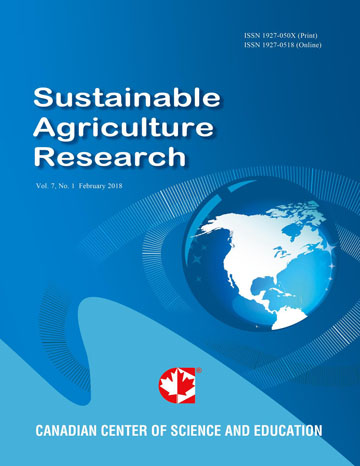Influence of Phosphorus Fertilizer on Potato Seed Production in Acid Soils in Kenya
- Evans Mutange Akoto
- Caleb O. Othieno
- Julius O. Ochuodho
Abstract
One of the major challenges facing potato (Solanum Tuberosum L) production in Kenya is the inadequate supply of high-quality seed. The required amount of potato seed in Kenya is about 70,000 tones annually but, only 1 % is available. Otherwise, farmers use low quality farm saved seed (KEPHIS, 2016). A major contributor to this situation is low and declining soil fertility, particularly phosphorus, among other challenges. Unfortunately, there is no available phosphorus fertilizer rate recommendation for seed potato production in Kenya. This hinders economic utilization of phosphorus fertilizers to achieve optimal production of quality potato seed in Kenya where its deficiencies are dominant. Therefore, this study investigated influence of different rates of phosphorus fertilizer on seed potato tuber yield and quality in three acidic (pH ≤ 5.8) test sites: Lari, Ainabkoi and Saboti sub Counties. Unica and Shangi varieties were tested. The field experiment was a split plot arrangement in Randomised Complete Block Design (RCBD) with six treatments (0 N & 0 P), 0, 30, 60, 90 and 120 kg ha-1 phosphorus, replicated three times. Data collected included tuber weight, number of tubers, tuber grade, number of eyes per tuber, tuber specific density and final germination percentage. To monitor soil nutrient dynamics, soil pH, soil available phosphorus, total nitrogen, total carbon, potassium, calcium, magnesium, copper, iron, zinc, sodium and exchangeable acidity (Lari only) were determined at planting while available phosphorus and potato tuber phosphorus were determined at harvesting. Data was statistically analysed using ANOVA at 5 % confidence levels with General Statistics (GENSTAT) and excel softwares. Results indicated that phosphorus rate significantly influenced seed tuber yield in the test sites. At Saboti, (0N & 0P) and no phosphorus application treatments for Shangi and Unica resulted in the highest seed tuber yield of 33.7 t ha-1 and 33.2 t ha-1, respectively. At Ainabkoi, application of 60 kg ha-1 and 30 kg ha-1 phosphorus produced the highest seed tuber yields of 20.0 t ha-1 and 18.9 t ha-1 of Shangi and Unica, respectively. In Lari, application of 60 kg ha-1 and 90 kg ha-1 phosphorus produced the highest seed tuber yields of 19.0 t ha-1 and 10.4 t ha-1 of Shangi and Unica, respectively. Unica had better final germination percentage than Shangi. During the season, there was a build-up of soil available phosphorus. Thus, there is need for farmers to test their soils at the onset of every potato season.
- Full Text:
 PDF
PDF
- DOI:10.5539/sar.v9n2p101
Index
Contact
- Joan LeeEditorial Assistant
- sar@ccsenet.org
